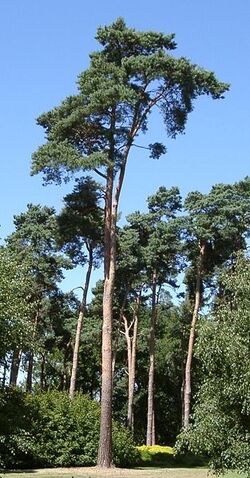| Vascular Plants | |
|---|---|
 | |
| Scientific classification | |
| Kingdom | Plantae |
| Subkingdom | Tracheobionta |
| Divisions | |
*Non-seed-bearing plants
| |
Vascular plants (also known as tracheophytes or higher plants) form a large group of plants that are very roughly defined. Vascular plants are those plants that have lignified tissues for conducting water, minerals, and photosynthetic products through the plant. Vascular plants include the clubmosses, Equisetum, ferns, gymnosperms (including conifers) and angiosperms (flowering plants). Scientific names for the group include Tracheophyta and Tracheobionta.
Characteristics[]
Vascular plants are distinguished by two primary characteristics:
- Vascular plants have vascular tissues which circulate resources through the plant. This feature allows vascular plants to evolve to a larger size than non-vascular plants, which lack these specialized conducting tissues and are therefore restricted to relatively small sizes.
- In vascular plants, the principal generation phase is the sporophyte, which is usually diploid with two sets of chromosomes per cell. Only the germ cells and gametophytes are haploid. By contrast, the principal generation phase in non-vascular plants is usually the gametophyte, which is haploid with one set of chromosomes per cell. In these plants, generally only the spore stalk and capsule are diploid.
One possible mechanism for the presumed switch from emphasis on the haploid generation to emphasis on the diploid generation is the greater efficiency in spore dispersal with more complex diploid structures. In other words, elaboration of the spore stalk enabled the production of more spore and the ability to release it higher and to broadcast it farther. Such developments may include more photosynthetic area for the spore-bearing structure, the ability to grow independent roots, woody structure for support, and more branching.
Water transport happens in either xylem or phloem: xylem carries water and inorganic solutes upward toward the leaves from the roots, while phloem carries organic solutes throughout the plant.
Phylogeny[]
A proposed phylogeny of the vascular plants after Kenrick and Crane is as follows, with modification to the gymnosperms from Christenhusz et al. (2011a) , Pteridophyta from Smith et al. and lycophytes and ferns by Christenhusz et al. (2011b) This phylogeny is supported by several molecular studies. Other researchers state that taking fossils into account leads to different conclusions, for example that the ferns (Pteridophyta) are not monophyletic.
Nutrient distribution[]

Photographs showing xylem elements in the shoot of a fig tree (Ficus alba): crushed in hydrochloric acid, between slides and cover slips.
Nutrients and water from the soil and the organic compounds produced in leaves are distributed to specific areas in the plant through the xylem and phloem. The xylem draws water and nutrients up from the roots to the upper sections of the plant's body, and the phloem conducts other materials, such as the sucrose produced during photosynthesis, which gives the plant energy to keep growing and seeding.
The xylem consists of tracheids, which are dead hard-walled hollow cells arranged to form tiny tubes to function in water transport. A tracheid cell wall usually contains the polymer lignin. The phloem however consists of living cells called sieve-tube members. Between the sieve-tube members are sieve plates, which have pores to allow molecules to pass through. Sieve-tube members lack such organs as nuclei or ribosomes, but cells next to them, the companion cells, function to keep the sieve-tube members alive.
The movement of nutrients, water and sugars is affected by transpiration, conduction and absorption of water.
Transpiration[]
The most abundant compound in all plants, as in all known life, is water which serves an important role in the various processes taking place. Transpiration is the main process a plant can call upon to move compounds within its tissues. The basic minerals and nutrients a plant is composed of remain, generally, within the plant. Water is constantly lost from the plant through its stomata to the atmosphere.
Water is transpired from the plants leaves via stomata, carried there via leaf veins and vascular bundles within the plants cambium layer. The movement of water out of the leaf stomata creates, when the leaves are considered collectively, a transpiration pull. The pull is created through water surface tension within the plant cells. The draw of water upwards is assisted by the movement of water into the roots via osmosis. This process also assists the plant in absorbing nutrients from the soil as soluble salts, a process known as absorption. Surprisingly, the movement of water upwards requires very little or no energy from the plant. Hydrogen bonds exist between water molecules, causing them to line up; as the molecules at the top of the plant evaporate, each pulls the next one up to replace it, which in turn pulls on the next one in line.
Absorption[]
Xylem vessels allow the movement of water and nutrients upwards towards the shoots and leaves through the roots and fine root hairs from the soil. Living root cells passively absorb water in the absence of transpiration pull via osmosis creating root pressure. It is possible for there to be no evapotranspiration and therefore no pull of water towards the shoots and leaves. This is usually due to high temperatures, high humidity, darkness or drought.
Conduction[]
Xylem and phloem tissues are involved in the conduction processes within plants. Sugars are conducted throughout the plant in the phloem and other nutrients through the xylem. Conduction occurs from a source to a sink for each separate nutrient. Sugars are produced in the leaves (a source) by photosynthesis and transported to the roots (a sink) for use in cellular respiration or storage. Minerals are absorbed in the roots (a source) and transported to the shoots to allow cell division and growth.
See also[]
- Fern allies
- Non-vascular plant